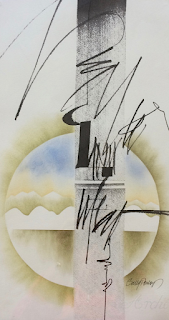Photo:
Review by Alec Clayton
Published in the Weekly Volcano, July 19, 2017
I hesitate to say
this is the best juried exhibition yet at South Puget Sound Community College
because I can’t trust my memory of previous ones. But I can say this: all
juried exhibitions have some great work, some mediocre work and a few pieces
that make you wonder how they were chosen, that make you think they didn’t have
enough entries and had to lower their judgement to fill the space. This year’s
juried exhibition has much more of the first of these and far fewer to others.
 |
“Maximus II” collage by Gail Ramsey Wharton, courtesy of the artist
|
Two pieces stand
out in my estimation. One is Faith Hagenhofer’s “Abundance,” and the other is
Bernie Bleha’s colorful, pop-surreal sculpture “Exotic Totem.” Hagenhofer’s
piece is a quilt made of wool and thread and, according to the wall label,
“plumbing parts.” There are a multitude of cone shaped tubes in tones of orange
and chartreuse arranged in alternating patterns that,
taken altogether, are an American flag.
There’s more to see in this one than eyes can take in in a single glance.
Bleha’s is a colorful totem pole in carved, glued and painted wood with strange
faces and exciting color.
There are also two paintings by Jason Sobatkka that, like Bleha’s piece,
can loosely be termed pop surrealist. They are inventive, strange and
compelling, and both feature bunny rabbits. “Logomorph Holy Spirit” was a
purchase award winner, but I prefer Sobatkka’s “Don’t Mess with the Pink
Rabbit,” acrylic, oil and glitter. A giant threatening
rabbit and a masked man are seen against backgrounds of bright ultramarine blue
and gold glitter. It’s a painting filled with surprising contrasts that is
simultaneously happy and ominous.
There’s a tiny
clay sculpture by Irene Osborn that is easily overlooked but should not be, a
sweet and classically beautiful nude sitting on a stump in a pose like Rodin’s
“The Thinker.”
People say
extremely realistic paintings look “just like a picture” (meaning a photograph.
Lou MacMillan’s digital photograph “Hall of Mosses, Hoh Rain Forest” turns that
inside-out. It’s photo that looks just like a painting —autumn in the rain
forest with thousands of golden leaves, each leaf standing out in stark detail
as if lifted off the surface. This photo is overwhelming in its
gorgeousness.
Two charcoal
drawings by Rebecca Smurr picture crowds of people as seen from above sprinkled
across the surface like leaves on snow. These are quite lovely. They
demonstrate how rich black and white can be.
Finally, despite
what I said about “Abundance” and “Exotic Totem,” my absolute favorite piece in
the show is Gail Ramsey Wharton’s “Maximus II,” a densely crowded collage with
a head of George Washington, a tattooed man wearing a tutu, two old men kissing,
and countless other surprises. Viewers can spend a lot of time joyfully
searching out all the surprising images and then step back to appreciate the
solidity of the overall composition. In past shows I’ve enjoyed her simple
collages, which often consist of clever and witty visual puns. This one is
quite different and exciting, not only because of the evident humor, but due to
its complex play of shapes and colors locking all the various pictures together
into a whole.
Southwest Washington Juried Exhibition, Noon to 4 p.m., Monday-Friday, through July 3, South Puget Sound
Community College, Kenneth J Minnaert Center for the Arts Gallery, 2011 Mottman
Rd. SW. Olympia










